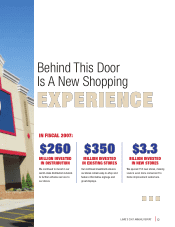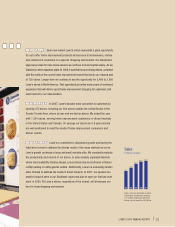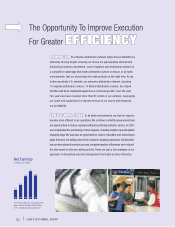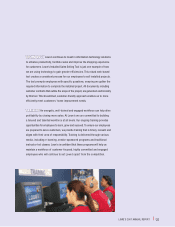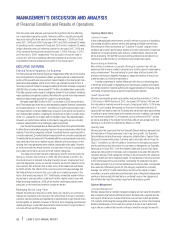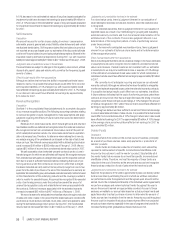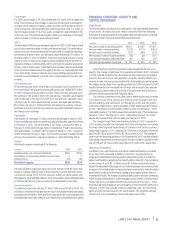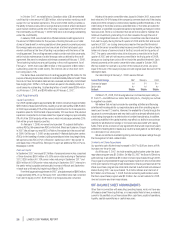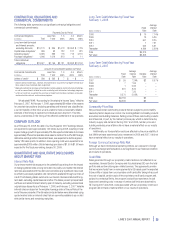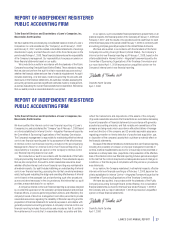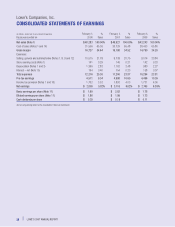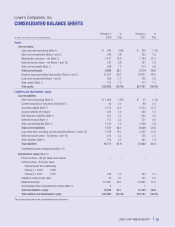Lowe's 2007 Annual Report Download - page 21
Download and view the complete annual report
Please find page 21 of the 2007 Lowe's annual report below. You can navigate through the pages in the report by either clicking on the pages listed below, or by using the keyword search tool below to find specific information within the annual report.LOWE’S 2007 ANNUAL REPORT |19
ensure consistent application of our policies and procedures under this evolving
model,but,by expanding the size of the average district and region in 2008,we
estimate we will save approximately $10 million through a combination of cost
avoidance and expense reductions.
Store Staffing
As sales have slowed, we have seen de-leverage in selling, general and
administrative expense, primarily as a result of store payroll. On an individual
store basis, our staffing model is designed to flucutate with departmental sales
levels,but we have established a minimum level of employee hours for each
department.As sales per store declined in 2007, more stores were meeting our
minimum staffing hours threshold, which increased the proportion of fixed to
total payroll expense.Although this creates short-term pressure on earnings,
in the long-term it ensures that we maintain the high service levels that cus-
tomers have come to expect from Lowe’s.However, we are continually refining
our store staffing model and as a result are planning a more conservative
build into the spring season this year.We do not believe this staffing plan will
affect service levels should sales outpace our plan,as we are confident that we
have the ability to add the hours needed to continue to provide great service if
sales ramp up more quickly than we expect.
Capital Management
New Store Expansion
We have looked critically at our capital plan for 2008 and have made the
decision to reduce the number of new store openings in 2008 to 120 stores.
Most of the reduction relates to stores that were planned for high-growth
markets like California and Florida, where current market conditions suggest
sales may fall short of our original forecasts.We know these markets will
recover, and we will be ready to add stores when conditions improve.Despite
the short-term pressures that have led to the decision to delay store openings
in certain markets, our long-term view of the industry has not materially
changed.We estimate that our 2008 capital plan was reduced by approxi-
mately $255 million, due to the reduction in new store openings planned for
2008. However, we do not see a significant overall reduction in the 2008
capital plan compared to prior years, due to higher costs of constructing
new stores, a shift in capital spending from 2007 to 2008 and investments
in 2008 for stores that will open in the first part of 2009.
Investing in Existing Stores
Our commitment to reinvesting in our existing store base remains strong.We
continue to gain unit market share by improving the shopping experience in
our stores and by adding innovative products and services that provide value
to customers. Despite the difficult sales environment, routine maintenance
will continue at the same pace, and we will continue to ensure that we deliver
a bright, clean, easy-to-shop store with appropriate merchandising.This is
part of what differentiates Lowe’s, and that will not change.However, we are
working to ensure that we are putting capital to use in ways that drive the best
return both short-term and long-term and will reduce the number of major
remerchandising projects in 2008 to approximately 80 from the 116 projects
that were completed in 2007.We expect capital expenditures related to major
remerchandising projects in existing stores to be approximately $80 million in
2008 versus $122 million in 2007.
CRITICAL ACCOUNTING POLICIES AND ESTIMATES
The following discussion and analysis of our financial condition and results
of operations is based on the consolidated financial statements and notes to
consolidated financial statements presented in this annual report that have
been prepared in accordance with accounting principles generally accepted in the
United States of America.The preparation of these financial statements requires
us to make estimates that affect the reported amounts of assets,liabilities,sales
and expenses,and related disclosures of contingent assets and liabilities.We base
these estimates on historical results and various other assumptions believed to
be reasonable, all of which form the basis for making estimates concerning the
carrying values of assets and liabilities that are not readily available from other
sources.Actual results may differ from these estimates.
Our significant accounting policies are described in Note 1 to the consolidated
financial statements.We believe that the following accounting policies affect
the most significant estimates and management judgments used in preparing
the consolidated financial statements.
Merchandise Inventory
Description
We record an inventory reserve for the loss associated with selling inventories
below cost.This reserve is based on our current knowledge with respect to
inventory levels, sales trends and historical experience. During 2007, our
reserve increased approximately $1 million to $67 million as of February 1,
2008.We also record an inventory reserve for the estimated shrinkage between
physical inventories.This reserve is based primarily on actual shrinkage results
from previous physical inventories.During 2007, the inventory shrinkage reserve
increased $8 million to $137 million as of February 1, 2008.
Judgments and uncertainties involved in the estimate
We do not believe that our merchandise inventories are subject to significant risk
of obsolescence in the near term, and we have the ability to adjust purchasing
practices based on anticipated sales trends and general economic conditions.
However,changes in consumer purchasing patterns or a deterioration in product
quality could result in the need for additional reserves. Likewise, changes
in the estimated shrink reserve may be necessary, based on the results of
physical inventories.
Effect if actual results differ from assumptions
Although we believe that we have sufficient current and historical knowledge
to record reasonable estimates for both of these inventory reserves,it is possible
that actual results could differ from recorded reserves. A 10% change in our
obsolete inventory reserve would have affected net earnings by approximately
$4 million for 2007.A 10% change in our estimated shrinkage reserve would
have affected net earnings by approximately $9 million for 2007.
Long-Lived Asset Impairment
Description
We review the carrying amounts of long-lived assets whenever events or changes
in circumstances indicate that the carrying amount may not be recoverable.
For long-lived assets held for use, a potential impairment has occurred if
projected future undiscounted cash flows expected to result from the use and
eventual disposition of the assets are less than the carrying value of the assets.
An impairment loss is recognized when the carrying amount of the long-lived
asset is not recoverable and exceeds its fair value.We estimate fair value based
on projected future discounted cash flows.
For long-lived assets to be abandoned, we consider the asset to be dis-
posed of when it ceases to be used.Until it ceases to be used, we continue to
classify the assets as held for use and test for potential impairment accord-
ingly. If we commit to a plan to abandon a long-lived asset before the end of
its previously estimated useful life, depreciation estimates are revised.
For long-lived assets held for sale,an impairment charge is recorded if the
carrying amount of the asset exceeds its fair value less cost to sell.Fair value
is based on a market appraisal or a valuation technique that considers various
factors,including local market conditions.A long-lived asset is not depreciated
while it is classified as held for sale.
Werecorded long-livedassetimpairmentchargesof$28 millionduring2007.
Judgments and uncertainties involved in the estimate
Our impairment loss calculations require us to apply judgment in estimating
expected future cash flows, including estimated sales and earnings growth
rates and assumptions about market performance.We also apply judgment in
estimating asset fair values,including the selection of a discount rate that reflects
the risk inherent in the company’s current business model.
Effect if actual results differ from assumptions
If actual results are not consistent with the assumptions and judgments used
in estimating future cash flows and asset fair values, actual impairment
losses could vary positively or negatively from estimated impairment losses.


